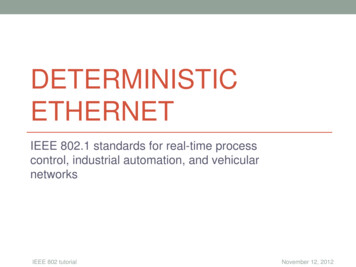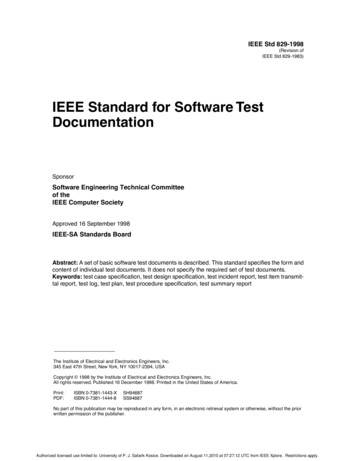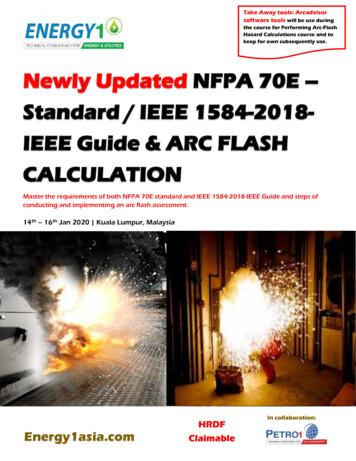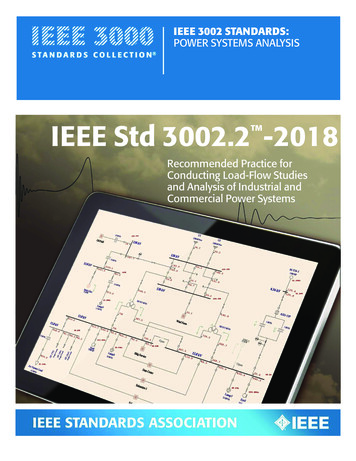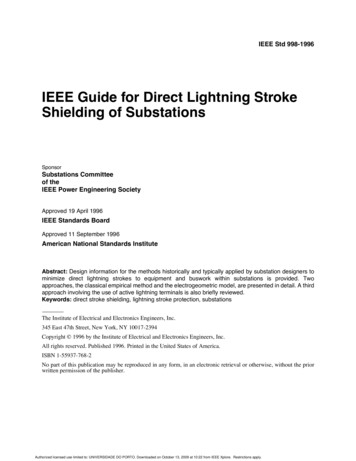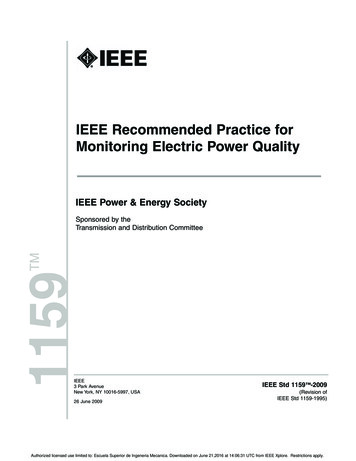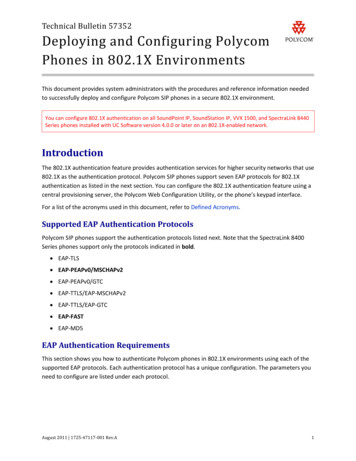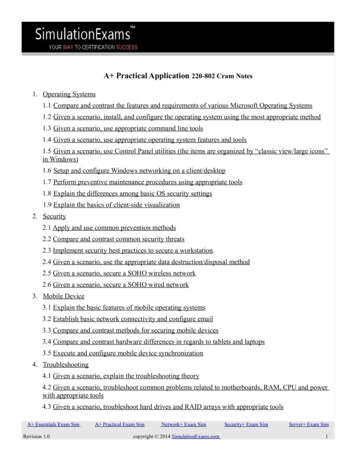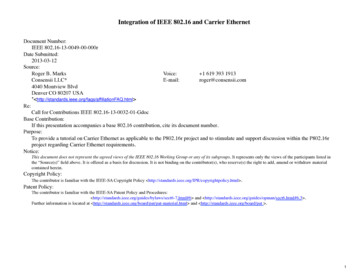
Transcription
Integration of IEEE 802.16 and Carrier EthernetDocument Number:IEEE 802.16-13-0049-00-000rDate Submitted:2013-03-12Source:Roger B. MarksVoice: 1 619 393 1913Consensii LLC*E-mail:roger@consensii.com4040 Montview BlvdDenver CO 80207 USA* http://standards.ieee.org/faqs/affiliationFAQ.html Re:Call for Contributions IEEE 802.16-13-0032-01-GdocBase Contribution:If this presentation accompanies a base 802.16 contribution, cite its document number.Purpose:To provide a tutorial on Carrier Ethernet as applicable to the P802.16r project and to stimulate and support discussion within the P802.16rproject regarding Carrier Ethernet requirements.Notice:This document does not represent the agreed views of the IEEE 802.16 Working Group or any of its subgroups. It represents only the views of the participants listed inthe “Source(s)” field above. It is offered as a basis for discussion. It is not binding on the contributor(s), who reserve(s) the right to add, amend or withdraw materialcontained herein.Copyright Policy:The contributor is familiar with the IEEE-SA Copyright Policy http://standards.ieee.org/IPR/copyrightpolicy.html .Patent Policy:The contributor is familiar with the IEEE-SA Patent Policy and Procedures: ml#6 and 6.3 .Further information is located at tml and http://standards.ieee.org/board/pat .1
Integration of IEEE 802.16and Carrier Ethernet contribution IEEE 802.16-13-0010 (“CarrierEthernet 2.0 Requirements for P802.16r”) said:– An understanding of the deployment architecture isrelevant to the understanding of the Carrier Ethernet2.0 Requirements and may be relevant to establishother general aspects of the required functionality tobe specified in the P802.16r project. This contribution is a followup. Carrier Ethernet tutorial information is included.2
Overview IEEE 802.16 can be enhanced to provideservices to SS-side Carrier Ethernet users IEEE 802.16 can be enhanced to leverageBS-side Carrier Ethernet networks Can support independent 802.16 operators Can support Carrier Ethernet networkoperators who want to add wireless3
Carrier Ethernet Network (CEN)CENUNIEVC CEN interconnects customer-edge Ethernet networks via Ethernet Virtual Connection(EVC)Customer-edge networks attach at a User-Network Interface (UNI)Attributes of UNI, EVC, Services, etc. are specified by Metro Ethernet ForumCopyright 2013 Consensii LLC4
Ethernet Private Line (EPL) ServiceCENE-LineEPL UNIEVCService Type: E-Line (point-to-point)Service Basis: port-basedCopyright 2013 Consensii LLC5
Ethernet Private LAN (EP-LAN) ServiceCENE-LANEP-LANUNIEVC Service Type: E-LAN (multipoint-to-multipoint)Service Basis: port-basedActs as a bridgeCopyright 2013 Consensii LLC6
Ethernet Private Tree (EP-Tree) ServiceCENE-TreeEP-TreeUNIEVCLeafPort Service Type: E-Tree (point-to-multipoint)Service Basis: port-basedActs as a bridge (but leaves forward only to roots)Copyright 2013 Consensii LLC7
Ethernet Virtual Private Line (EVPL)CE-VLANEVCA,B1CE-VLANEVCX,Y, no tag2CENEVC 1EVPLEVCEVC2EVPL UNICE-VLANEVCA,BX,Y, no tag12Service Type: E-Line (point-to-point)Service Basis: VLAN-basedService Multiplexing by CE-VLAN Tag (C-TAG) [CE: Customer-Edge]V-LAN CoordinationNot transparent to customer VLANCopyright 2013 Consensii LLC8
Ethernet Virtual Private LAN (EVP-LAN) E-VLANEVCX,Y2A,BX,Y12EVCEVC2EVP-LAN Service Type: E-Tree (point-to-multipoint)Service Basis: VLAN-basedService Multiplexing by CE-VLAN TagV-LAN CoordinationNot transparent to customer VLANActs as a bridgeCopyright 2013 Consensii LLC9
Ethernet Virtual Private Tree (EVP-Tree) LANEVCX,Y2A,BX,Y12EVC2EVP-Tree UNIEVCLeafPortService Type: E-LAN (multipoint-to-multipoint)Service Basis: VLAN-basedService Multiplexing by CE-VLAN TagV-LAN CoordinationNot transparent to customer VLANActs as a bridge (but leaves forward only to roots)Copyright 2013 Consensii LLC10
External Network-Network Interface (ENNI)CENUNIEVCENNIOVCOVC Interconnection between to Operator CENsSupports EVCs with ports in multiple CENsAssembled from Operator Virtual Connections (OVCs)Copyright 2013 Consensii LLC11
Point to Point OVCsFromCE-VLANMap To1XOVC 1-2CENUNIEVC1EVC 1-4E-LineENNIOVC 1-23FromCE-VLAN4XOVC 3-44OVC2FromAdd S-Tag2NOVCcoordinatedFromRead S-TagMap To3NOVC 3-4Copyright 2013 Consensii LLC12
Point to Multipoint OVCsFromCE-VLANMap To1XOVC 1-2CENUNIEVCFromCE-VLAN5X1EVC 1-4-5E-LANENNIOVC 1-253FromCE-VLAN4XOVC2OVC 3-4-5FromAdd S-Tag2NOVC4coordinatedFrom3Copyright 2013 Consensii LLCStrip S-TagNMap ToSwitched ToOVC 3-4-5Endpoint4 or 5(switched byMACaddress)13
802.16 Access 02.16ASNSSportCopyright 2013 Consensii LLC14
802.16 Use Case 1: Ethernet PortConnection to CENUNI with Service MultiplexingPortsEthernet (not UNI-qualified)FunctionEthernet beyond the UNIOperatorIndependent 802.16 OperatorCertificationnoneSLAdifficultCopyright 2013 Consensii LLC15
802.16 Use Case 1 : UNI-Like Ethernet 6ASNSSportUNI-likeConnection to CENUNI with Service ent beyond the wired CENOperatorIndependent 802.16 OperatorCertificationself (initially)SLAdifficultCopyright 2013 Consensii LLC16
802.16 Use Case 2: CEN ExpansionCENUNIEVCENNIOVCOVCCopyright 2013 Consensii LLC17
802.16 Use Case 2 : Standalone CENCENUNIEVCENNIOVC802.16OVC802.16ASNBSConnection to CENENNIPortsUNIServiceEVC beyond the wired CENOperatorIndependent 802.16 OperatorCertificationMEFSLAMEF-specifiedCopyright 2013 Consensii LLC18
802.16 Network Backhaul Architecture Merged Control and Data 6ASN802.16 Control(AAA, etc.)andDataCopyright 2013 Consensii LLC19
802.16 Network Backhaul Architecture Separate Control and Data .16 Control(AAA, etc.)Copyright 2013 Consensii LLC20
S2802.16 Control(AAA, etc.)802.16SSbSS1abNetwork Architecturewith Typical ScenarioCopyright 2013 Consensii LLC21
Bridging in 802.16 Bridging is not explicit in the 802.16 architectural model 802.16 does not specify bridge operation⁃ ISS support specified in 802.16k (amendment 802.1D)⁃ does not directly specify bridging⁃ RFC 5692 specifies bridging (details below)⁃ 802.1Q and VLAN-aware bridging not addressedCopyright 2013 Consensii LLC22
Scope of 802.16 standardMAC CommonPart Sublayer(MAC CPS)Security SublayerCX Management PartDistributed CoexistenceInformation DatabaseDistributed RadioResource ManagementCoexistence Protocol(CXP)PHYPHY SAPPhysical Layer(PHY)Data PlaneM SAPMACMAC SAPManagement PlaneManagementInformation Base (MIB)C SAPService SpecificConvergence Sublayer(CS)Network Control and Management System802.16 EntityCS SAPManagement/Control PlaneFigure 1-1—IEEE 802.16 protocol layering, showing SAPsCopyright 2013 Consensii LLC23
Bridging Issues bridging forwards frames to bridge ports⁃ 802.16 MAC transports data on connections⁃ connections are currently identified by SS, not by end port⁃ connection should connect bridge port to SS port possible solutions:(1) forward frames from BS to a single port per SS⁃specified in RFC 5692⁃unnecessary and duplicative bridging burden in SS⁃add'l bridging management over the air(2) insert a tag (such as S-Tag)(3) bridge-centric architecture using port identificationCopyright 2013 Consensii LLC24
Bridge Solution (1): single port per SSRFC 5692 ("Transmission of IP over Ethernet over IEEE 802.16Networks") says: "The BS MUST forward all the service flows belonging to oneSS to one port of the network-side bridging function." "If the Ethernet over IEEE 802.16 is extended to multiple endstations behind the SS , then the SS SHOULD supportbridging according to [802.1D] and its amendment [802.16k],a.k.a. subscriber-side bridge, between all its subscriber-sideports and the IEEE 802.16 air link."Notes: In RFC 5692, bridge may serve multiple BSs; here only one RFC 5692 is not referenced in IEEE 802.16-2012Copyright 2013 Consensii LLC25
Bridge Solution (2): insert a tag An additional port identification field could be inserted into theframefor example, as an S-Tag This extra over-the-air multiplexing overhead is unnecessary,since the connection methodology already provides pathseparation.Copyright 2013 Consensii LLC26
BSin802.1QBridgeBSPortSSPort 1SSPort 2Bridge-Centric ArchitectureSSPort 1SSPort 3SS aSSPort 2BridgeSolution (3)SSPort 3multiple SS Ports per SSone SS per SS PortSS bConvergenceSublayerOne CS instance per SSPort-aware CSunidirectionalConnectionsMAC CPSmultiple Connections per SS Portone SS Port per ConnectionConnections labeled by SS PortPHYall Connections linked via PHY[several examples highlighted]Copyright 2013 Consensii LLC27
SS1BSPortUNI-NSS1Port bSS2Port aSS2Port bForward tobridge basedon C-Tag,usingconfiguredEVC table.UNI-CNote: Need notbe processed insequence shownVLAN C-TagDemultiplexingSS1Port aSS2UNI-NUNI-CVLAN MappingConvergence SublayerPHSApplyPHSRestoreMAC CPSMAC CPSPHYDownlink, Use Case 1 Copyright 2013 Consensii LLCConnectionsPHY28
SS1UNI-NBSPortSS1Port aSS2SS1Port bSS2Port aSS2Port torePHSApplyMAC CPSMAC CPSPHYUplink, Use Case 1 Copyright 2013 Consensii LLCPHY29
SS1UNI-NBSPortSS1Port aSS2SS1Port bSS2Port aSS2Port bUNI-NUNI-CUNI-CVLAN C-TagDemux/StripVLAN C-TagMultiplexingBridgingConnectionMappingAdd VLANC-TagConvergence SublayerPHSApplyPHSRestoreMAC CPSMAC CPSPHYDownlink, Use Case 1 , VLAN C-Tag StrippingCopyright 2013 Consensii LLCPHY30
SS1UNI-NBSPortSS1Port aSS2SS1Port bSS2Port aSS2Port BridgingConnectionMappingCSCSPHSRestorePHSApplyMAC CPSMAC CPSPHYUplink, Use Case 1 , VLAN C-Tag StrippingCopyright 2013 Consensii LLCPHY31
SS1UNI-NBSPortSS1Port aSS2SS1Port bSS2Port aSS2Port bUNI-NUNI-CUNI-CInitialClassificationVLAN C-TagMultiplexingBridgingConnectionMappingAdd VLANC-TagConvergence SublayerPHSApplyPHSRestoreMAC CPSMAC CPSPHYDownlink, Use Case 1 , Pre-ClassificationCopyright 2013 Consensii LLCPHY32
SS1UNI-NBSPortSS1Port aSS2SS1Port bSS2Port aSS2Port HSApplyPHSApplyMAC CPSMAC CPSPHYUplink, Use Case 1 , Pre-ClassificationCopyright 2013 Consensii LLCPHY33
SS1BSPortENNI-NENNI-NNote: Need notbe processed insequence shownS-Tag stripand forwardSS1Port aSS2SS1Port bSS2Port aSS2Port bStrip ingressS-Tag.Forward tobridge basedon S-Tag,usingconfiguredOVC table.BridgingENNI-NENNI-NAdd egress S-Tag using configured OVC table.Add egressS-TagConnectionMappingConvergence SublayerPHSApplyPHSRestoreMAC CPSMAC CPSPHYDownlink, Use Case 2 , ENNI to ENNICopyright 2013 Consensii LLCPHY34
SS1ENNI-NBSPortSS1Port aSS2SS1Port bSS2Port aSS2Port bENNI-NENNI-NENNI-NS-Tagging pingConnectionMappingCSCSPHSRestorePHSApplyMAC CPSMAC CPSPHYUplink, Use Case 1 Copyright 2013 Consensii LLCPHY35
SS1BSPortENNI-NENNI-NNote: Need notbe processed insequence shownS-Tag stripand forwardSS1Port aSS2SS1Port bSS2Port aStrip ingressS-Tag.Forward tobridge basedon S-Tag,usingconfiguredOVC table.SS2Port bUNI-NUNI-CBridgingConnectionMappingConvergence SublayerPHSApplyPHSRestoreMAC CPSMAC CPSPHYDownlink, Use Case 2 , ENNI to UNICopyright 2013 Consensii LLCPHY36
EPCCENUNIEPCEVCENNIOVCOVC802.16ASNaX2SS2802.16 Control(AAA, synch etc.)EthernetPort802.16BS PortsLTELTEb802.16SS PortsWi-FiaSS1bDual-ModeSCBCopyright 2013 Consensii LLCSmall-CellBackhaulExample37
Matching Connections and PortsUpper Layer Entity (e.g., bridge, router, host)Upper Layer Entity (e.g., bridge, router, host)SDUSDUSAPSAPCID 1CID 2DLClassificationRuleReconstitution(e.g., undo PHS).CID n{SDU, CID, .}{SDU, CID.}SSBSSAPSAPIEEE 802.16 MAC CPSIEEE 802.16 MAC CPSFigure 5-5—Classification and CID mapping (BS to SS)Classification (IEEE Std 802.16-2012):Properties of a Connection include:Connection ID (CID)SS IDQoS parametersClassification rules (with priorities)Classification (proposed enhancement):Properties of a Connection include:Connection ID (CID)SS ID & global Port ID [could be SS ID & SS-Local Port ID]QoS parametersClassification rules (with priorities)During classification, Convergence Sublayer (CS) does:parse frameidentify table of all applicable rulesall rules are eligiblecompares frame elements to rules, in priority orderassigns frame to first CID that satisfies a ruleDuring classification, Convergence Sublayer (CS) does:parse frameidentify table of all applicable rulesinclude only rules that map to the egress portcompares frame elements to rules, in priority orderassigns frame to first CID that satisfies a ruleCopyright 2013 Consensii LLC38
Needed IEEE 802.16 Enhancement:Bridging Specify bridging at BS port– Currently, IEEE Std 802.16k (amendment to 802.1D)specifies the means for 802.1D bridging service tooperate with the IEEE 802.16 Packet ConvergenceSublayer– Need to introduce bridging explicitly into the 802.16architecture– Need to also specify operation of VLAN-aware Bridgesupporting the 802.1Q ISS & EISS service Consider use of service access point identifier andconnection identifier service primitive parameters– Avoid additional bridging at the SS.39
Needed IEEE 802.16 Enhancement:Port ID per Service Flow Add Port ID parameter to “Service flowencodings” (Table 11-53) to identify SS Port– Multiple service flows can service each Port based on, for example, QoS or PHS issues– Need a globally-unique Port ID parameter Could be SS ID plus unique SS-Local Port ID.– Associate Service Flow with global Port ID.– Bridge identifies incoming SS frames by source Port,and assigns outgoing SS frames to destination Port.– Any Connection associated with the correct global PortID will deliver the frame to the right Port.40
Needed IEEE 802.16 Enhancement:Bridge-Aware Packet CS Enhance “IEEE 802.3/Ethernet-specific part” ofPacket Convergence Sublayer Ensure that the CS is aware of (a) the BridgePort of the frame and (b) the Port ID of eachconnection– CS will identify Port to bridge at bridge ingress– CS empowered to assign MAC-bound PDUs only toconnections associated with designated Bridge Port– Incoming CS data at SS will be forwarded to thecorrect port based on Port ID– Dedicate an SS port for SS management.41
Applicability of GPCS IEEE Std 802.16 offers an alternative CS:General Packet Convergence Sublayer (GPCS) Detailed GPCS functionality is declared out ofscope.– Specification of CS functionality is critical to meetingCarrier Ethernet QoS requirements. GPCS multiprotocol feature is not relevant toCarrier Ethernet. Carrier Ethernet demands a specific CS, not ageneric one.42
Support of Ethernet Hostsbeyond the SS Port For multiple hosts beyond the SS Port, bridgingbeyond the SS Port is needed– Not part of the IEEE 802.16 SS The architecture supports the external bridge The architecture allows for some efficiencyoptimization– For example: For a frequently-addressed 802.3 MACdestination outside the SS, a Connection can beinitiated for that destination alone in order to make useof payload header suppression, suppressing thedestination address43
Metro Ethernet Forum (MEF) functionalityand attributes needed Carrier Ethernet requirements go well beyond thearchitecture. The Metro Ethernet Forum specifies manyfunctionalities and attributes Many Carrier Ethernet 2.0 requirements are in:– Carrier Ethernet 2.0 Certification Blueprint– see also IEEE 802.16-13-0010 First Carrier Ethernet 2.0 certifications: Jan 2013– All 4 service types: E-Line, E-LAN, E-Tree, E-Access44
Carrier Ethernet 2.0 Summary(1) Key UNI Service Attributes Port-Based (EPL, EP-LAN, EP-Tree):– No Service Multiplexing: one service per port– All to One Bundling (all VLANs forwarded to service)– No ingress or egress bandwidth profile (BWP) per UNI VLAN-Based (EVPL, EVP-LAN, EVP-Tree):– Service Multiplexing allowed: multiple services per port– Bundling of VLANs onto a service allowed Requires VLAN preservation45
Carrier Ethernet 2.0 Summary(2) Key EVC Service Attributes At least one CoS is required– values/objectives for each performance attribute withobjectives and parameters defined in MEF 23.1– See slides below beginning with “Carrier Ethernet QoS” Port-Based (EPL, EP-LAN, EP-Tree):– CE-VLAN ID Preservation– CE-VLAN CoS Preservation VLAN-Based (EVPL, EVP-LAN, EVP-Tree):– CE-VLAN ID Preservation: optional– CE-VLAN CoS Preservation: optional46
Carrier Ethernet 2.0 Summary(3) Key EVC per UNI Service Attributes Port-Based (EPL, EP-LAN, EP-Tree):– All Service Frames at the UNI must map to one EVC VLAN-Based (EVPL, EVP-LAN, EVP-Tree):– Specify mapping table of CE-VLAN IDs to EVC ID47
Carrier Ethernet 2.0 Summary(4) Service OAM Frames Operations, Administration, and Maintenance Various Connectivity, Linktrace, and Loopbackmessage handling requirements “Carrier Ethernet 2.0 Service OAM enables the subscriberand the service provider to check continuity of a given EVCacross the entire service, to trace the path of a service orping a target MEP (Maintenance association End Point) orconfigured MIP (Maintenance domain Intermediate Point),for subscriber and test MEG (Maintenance Entity Group)levels defined in MEF 30 ‘Service OAM FM ImplementationAgreement’.”48
Carrier Ethernet 2.0 Summary(5) E-Access Services E-Access: Point to Point OVC (ENNI/UNI)– Other OVC configurations not currently certifiable Many Attributes––––––UNI Service AttributesENNI Service AttributesOVC per UNI Service AttributesOVC Endpoint per ENNI Service AttributesOVC Service AttributesService OAM Frames Handling49
Carrier Ethernet 2.0 Backhaul MEF Carrier Ethernet for Mobile Backhaul Initiative is basedon Carrier Ethernet 2.0 but introduces additionalrequirements specifically for backhaul purposes.– “New Mobile Backhaul Initiative to Resolve 4G/LTE Backhaul’s MostCostly Challenge” calls out:– MEF 22.1 (“Mobile Backhaul Phase 2”) Indicates importance of network-based synchronization support, providing guidance throughthe paper “Packet Synchronization over Carrier Ethernet Networks for Mobile Backhaul – AFormula for Deploying IEEE 1588v2 and Synchronous Ethernet: Investigate – Test – Deploy.” specifies requirements on Service OAM, Ethernet OAM, and synchronization, along withother issues– MEF 23.1 (“Carrier Ethernet Class of Service – Phase 2”) See also MEF 23.1 overview slides50
Carrier Ethernet QoS QoS is a core and complex facet of MEF specs Key concepts:–––––––––Bandwidth profile (BWP)Information RateBurst SizeCommitted vs ExcessColorPCPCoSPerformance Service AttributesCoS Performance Objectives (CPOs)51
Carrier Ethernet BWP Process Committed Information Rate (CIR), Committed Burst Size(CBS), Excess Information Rate (EIR), and Excess BurstSize (EBS) agreed by provider and subscriber (in SLA) Service Frames are observed– at ingress and/or egress– at UNI and/or EVC, or per CoS 8-level CoS can by identified by 3-bit PCP field in C-Tag or S-Tag Service Frames are marked– Up to CIR/CBS: Green; delivered per performance objectives– Beyond CIR/CBS but up to EIR/EBS: Yellow; delivered as best effort– Beyond EIR/EBS: Red; discarded52
Performance Service Attributes Performance Service Attributes:– QoS description, per CoS MEF 23.1 speci
relevant to the understanding of the Carrier Ethernet 2.0 Requirements and may be relevant to establish other general aspects of the required functionality to be specified in the P802.16r project. This contribution is a followu


